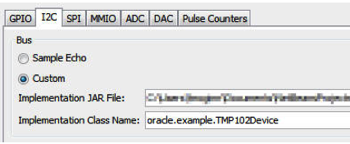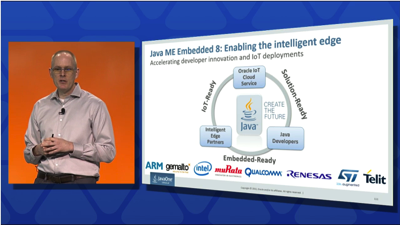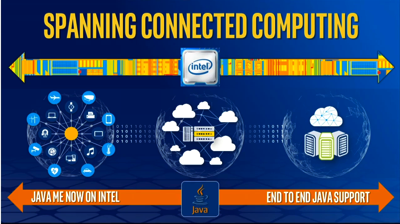You are currently browsing the tag archive for the ‘devices’ tag.
Tag Archive
JavaOne Recap 2: Java ME Embedded 8 endorsed by leading partners in the device space
11/03/2015 in Embedded | Tags: ARM, devices, edge, Gemalto, Intel, iot, Java ME, Java ME Embedded 8, muRata, Oracle, platforms, Qualcomm, Renesas, SoC, STM, Telit | Leave a comment
On the heels of recap #1 – here is recap #2 from the JavaOne 2015 Java ME keynote:
Java ME Embedded 8 endorsed by leading partners to enable intelligent edge devices:
For more details, see the video replay of the JavaOne Java ME keynote starting at 1hr:7min:50sec.
Cheers,
— Terrence
JavaOne Recap 1: Intel and Oracle collaborate on Java ME
11/01/2015 in Embedded | Tags: devices, edge, Intel, iot, Java ME, Java ME Embedded 8, Oracle, platforms | Leave a comment
Following up JavaOne with a few postings to recap the week’s Java ME news:
Recap #1 is from Intel’s JavaOne 2015 keynote:
Intel and Oracle announce collaboration to bring Java ME to intelligent edge devices built on Intel architecture.
For the full announcement, see the video replay of the Intel keynote starting at 10 min 30 secs.
Cheers,
— Terrence
Custom I/O devices with Java ME SDK 3.3
09/09/2013 in Embedded | Tags: devices, embedded, GPIO, I2C, Java ME Embedded, Java ME SDK | Leave a comment
 One of the core requirements for embedded Java applications is the ability to access I/O devices, such as sensors, switches, converters, actuators, LEDs, and so on to enable the embedded system to interact with the world around it.
One of the core requirements for embedded Java applications is the ability to access I/O devices, such as sensors, switches, converters, actuators, LEDs, and so on to enable the embedded system to interact with the world around it.
Java ME Embedded includes the Device Access API (DAAPI), which is a comprehensive API that provides access to a range of common I/O devices directly from your Java application in an easy and platform-independent manner. No native code, recompilation, or other “traditional embedded trickery” required.
That works great if you have your target platform already available and up-and-running. But what if you want to start software development before your target platform hardware is available? Or you want to develop most of the code on a Desktop PC for convenience and speed purposes? The Java ME SDK has you covered.
The Java ME SDK offers a set of tools as well as plugins for NetBeans and Eclipse which allow you to develop Java ME Embedded applications efficiently and leveraging your existing Java expertise. Another great feature is that it includes a full emulation runtime which emulates a Java ME Embedded target platform on the PC. Furthermore, the Java ME SDK also includes a tool called the “Custom Device Editor”, which allows you to customize the emulation runtime to your needs (for example, by adding the specific I/O devices of your actual target hardware) and even allows you to implement simulated device behavior (in Java, of course).
To get started with custom I/O devices in the Java ME SDK, check out an excellent blog post Tom McGinn from the Oracle Education Team, explaining how to add and simulate an I2C temperature sensor.
Cheers,
— Terrence
Moving towards Java ME 8: Proposal for updated Device Access API
07/14/2013 in Embedded | Tags: "Java ME 8", API, devices, embedded, Java Embedded, javadocs | 23 comments
Update 715/13: Added a note on target platforms.
A key feature of Java ME Embedded is the ability for developers to access peripheral devices directly from Java application code. This significantly simplifies development effort because the device-related code is much easier to write, portable across platforms, and there is no need for complicated native code development and integration.
The latest Device Access API is available in Java ME Embedded 3.3, and already supports a host of features, interfaces, and peripherals such as GPIO pins, I2C and SPI busses, serial communication and modems, ADC and DAC converters, pulse counters, and more.
For Java ME 8, we plan to enhance the Device Access API even further by including support for the new Java ME 8 language features aligned with Java SE 8 (such as Generics, Annotations, Try-with-Resources, and so on), adding a few more popular functions (pulse-width-modulation (PWM) output and more), and making the API available as a standard for Java ME and Java SE.
Because hardware integration is such a broad and potentially complex topic we would like to hear from developers: Does the Device Access API meet your needs? Do you see any potential pitfalls and shortcomings? To this effect, we just published the javadocs for the “Device Access API Proposal for Java ME 8”. Please have a look and give us your feedback, either as a comment to this blog entry, or via email.
Cheers,
— Terrence
Webinar, June 27: Application Intelligence and Connected Devices
06/26/2013 in Embedded | Tags: Connected, devices, iot, Java Embedded, Java ME Embedded, M2M, webinar | Leave a comment
Oracle and Beecham have recently conducted a market survey on use of Connected Devices for M2M & Internet of Things (IoT) applications and new trends.
On June 27, 9 am ET the first session in this webinar series addresses intelligence in connected devices. Join Peter Utzschneider from Oracle and Robin Duke-Woolley of Beecham Research as they discuss the findings from this survey and the implications for the M2M & IoT connected devices market:
- What are the key business drivers of your connected devices program?
- To what extent do you expect the intelligence required for M2M & IoT applications to change?
- Would these changes occur at the network edge, at the data center, or both?
- What are the impacts of these changes on ISV’s and device manufacturers?
- What are the opportunities for other M2M & IoT players?
To attend, please register for free or click on the image.
Cheers,
— Terrence





Recent Comments